Abstract
1. The relationship between myosin heavy chain (MyHC) isoforms and high energy phosphate content was studied in human muscle fibres at rest and following maximal dynamic exercise lasting 25 s. 2. Single fibre fragments were characterized as type I, type IIA, type IIX or type IIAX. These latter fibres were subdivided into five groups on the basis of the proportion of MyHC IIX isoform present. 3. Resting ATP concentration in type I fibres was 10% lower than in type II fibres (P < 0.05), but no differences were found amongst type IIA, IIX and IIAX fibre groups. Phosphocreatine (PCr) content was lower in type I than in type II fibres (P < 0.01) and, amongst type II fibres, increased progressively with the amounts of MyHC IIX expressed. 4. After 25 s of maximal dynamic exercise ATP concentration was reduced in all fibres. The decrease was approximately 25% in type I fibres and between 47 and 66% in the type II subgroups. 5. Post-exercise PCr content was low in all fibre types. Fibre groups with the lowest post-exercise PCr also had the lowest ATP and the highest inosine monophosphate contents. delta PCr (rest to post-exercise) was smallest in type I fibres and showed a progressive increase in the type II fibre groups as the proportion of the faster IIX myosin heavy chain isoform increased.
Full text
PDF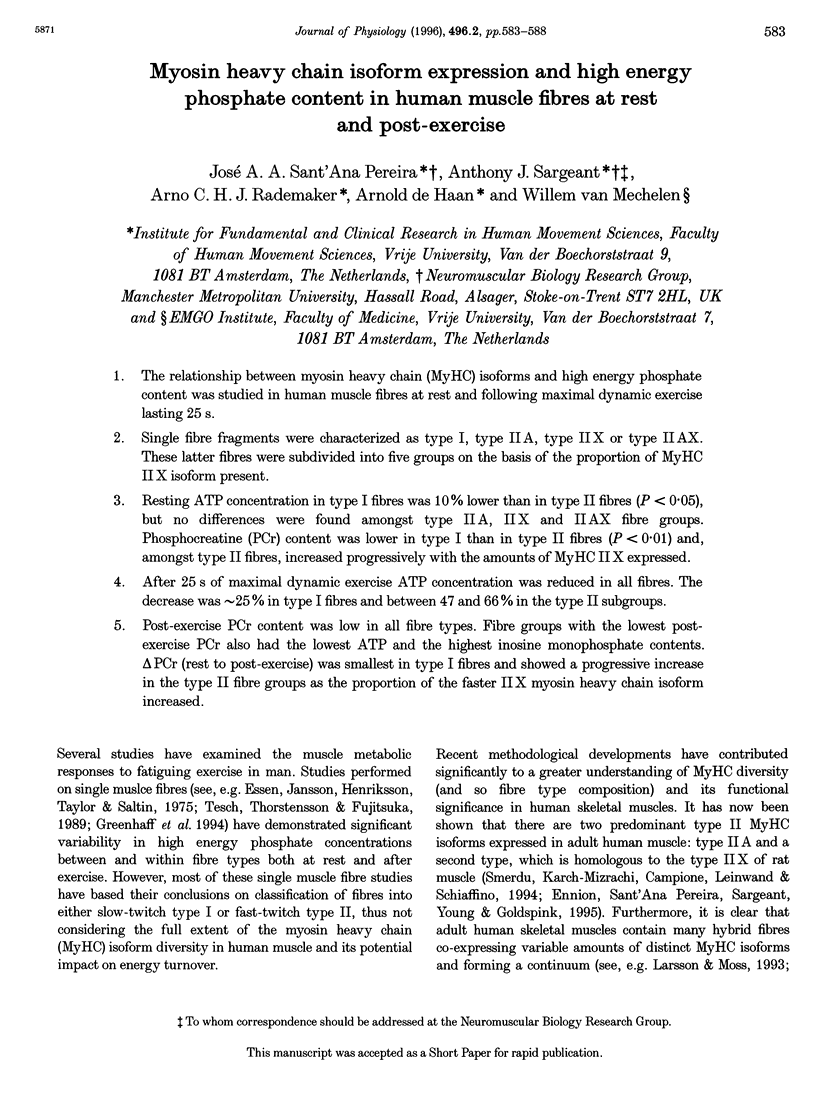
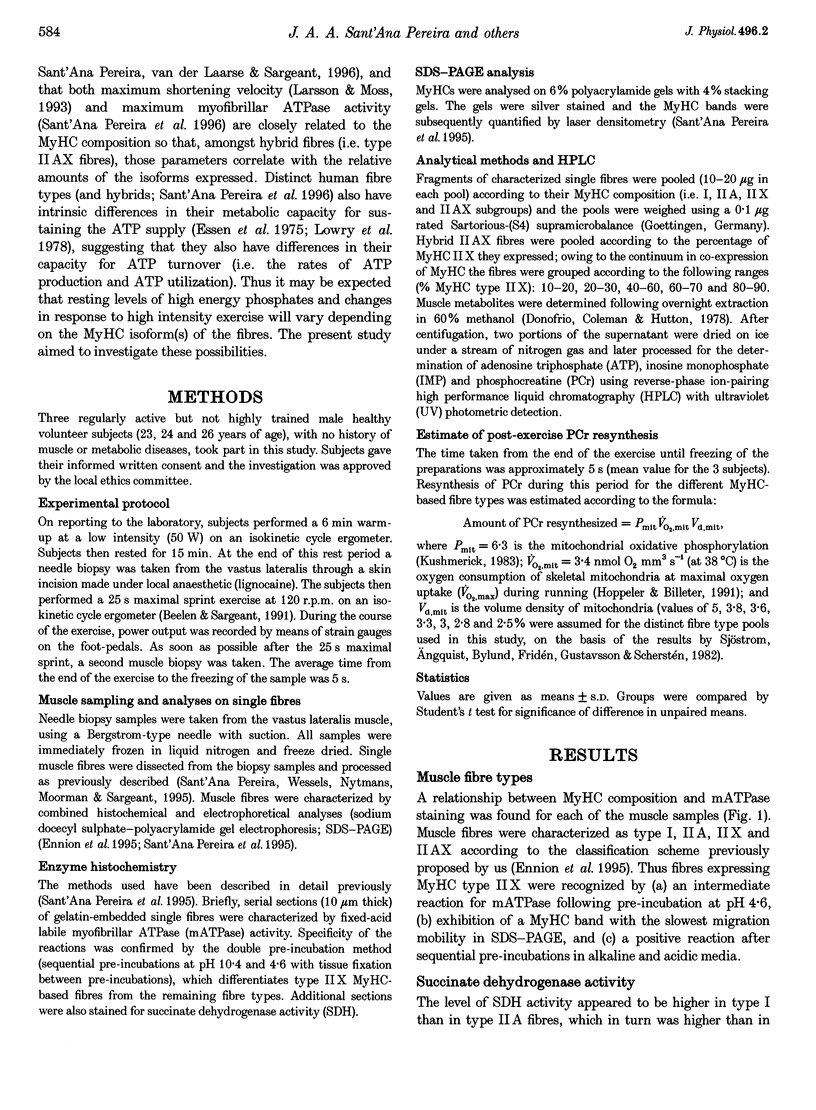
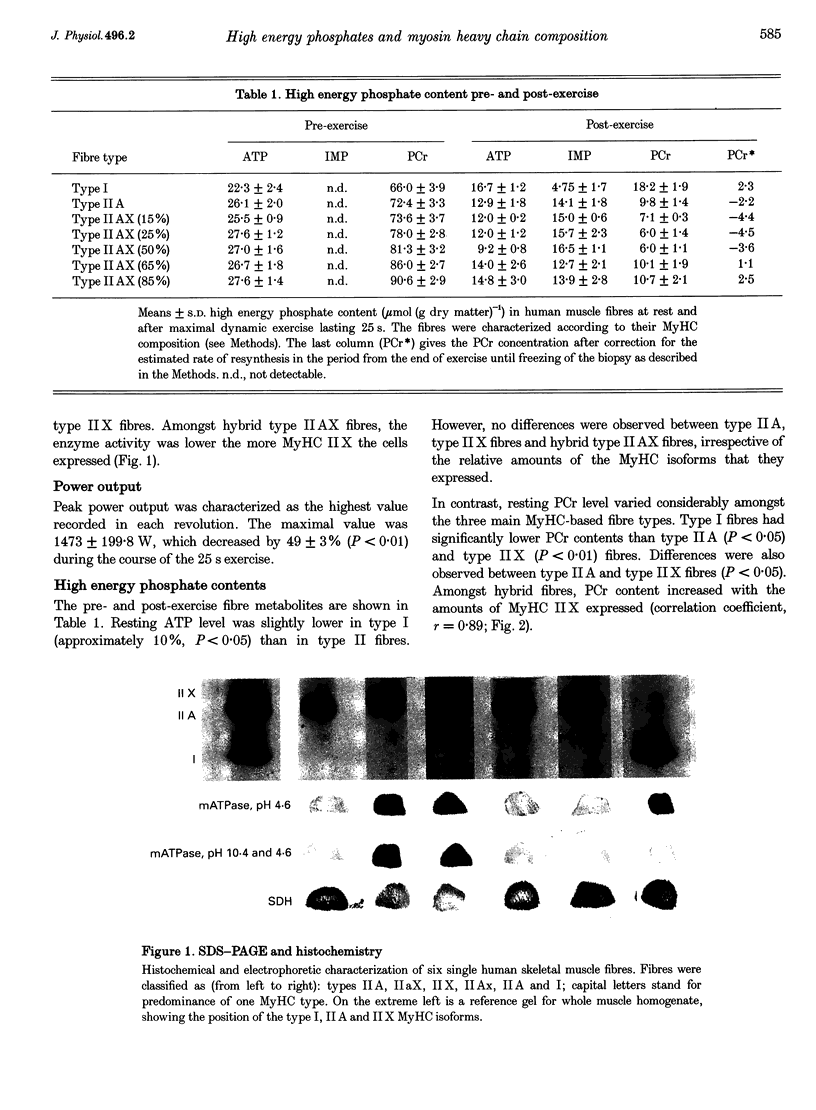
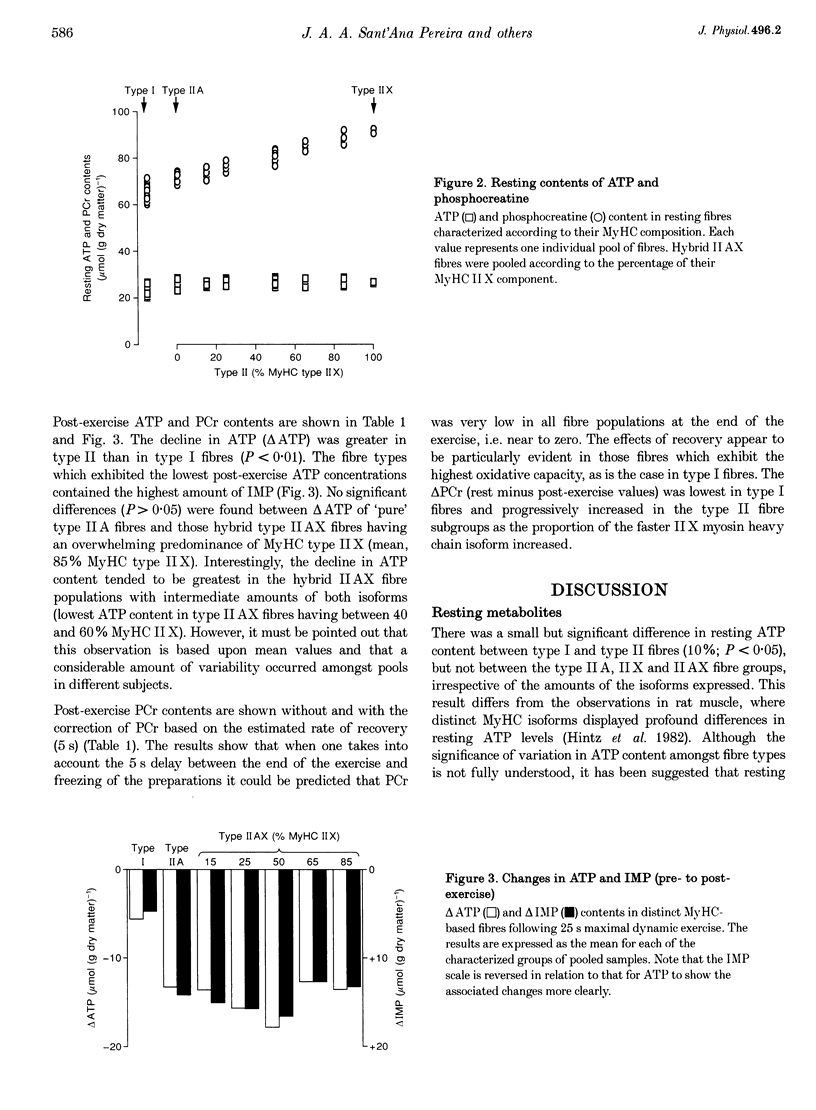
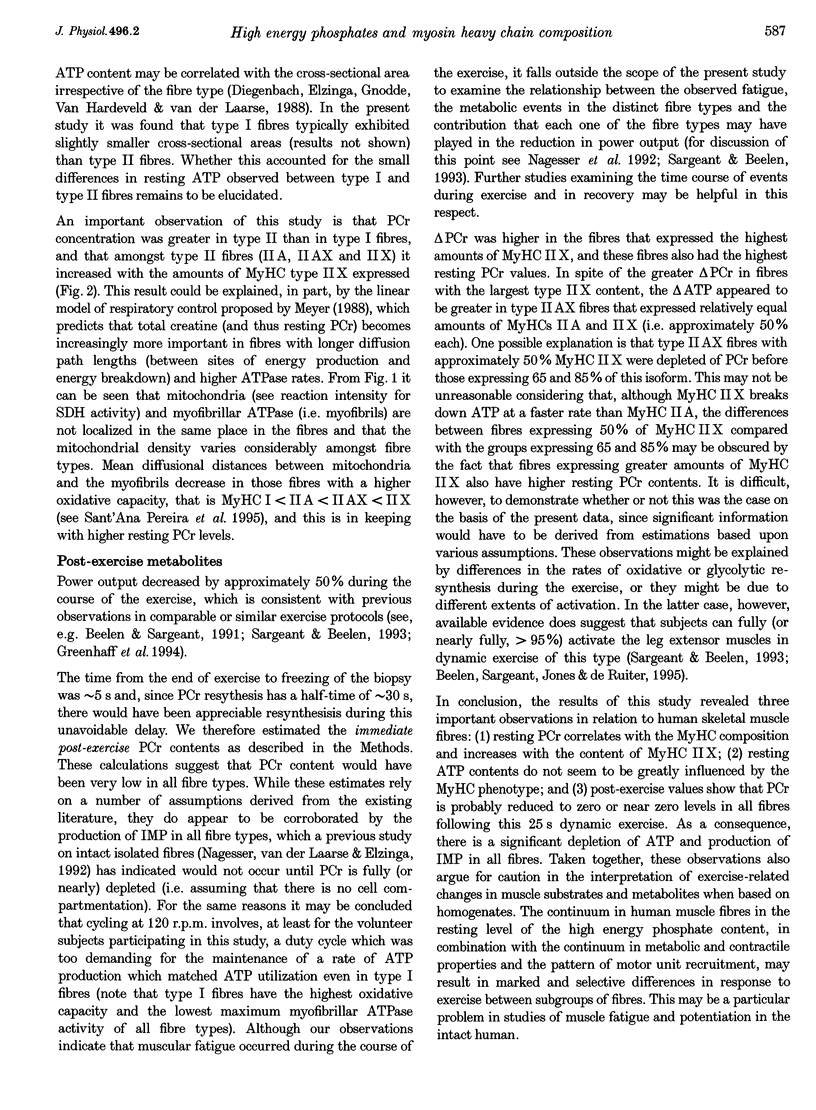
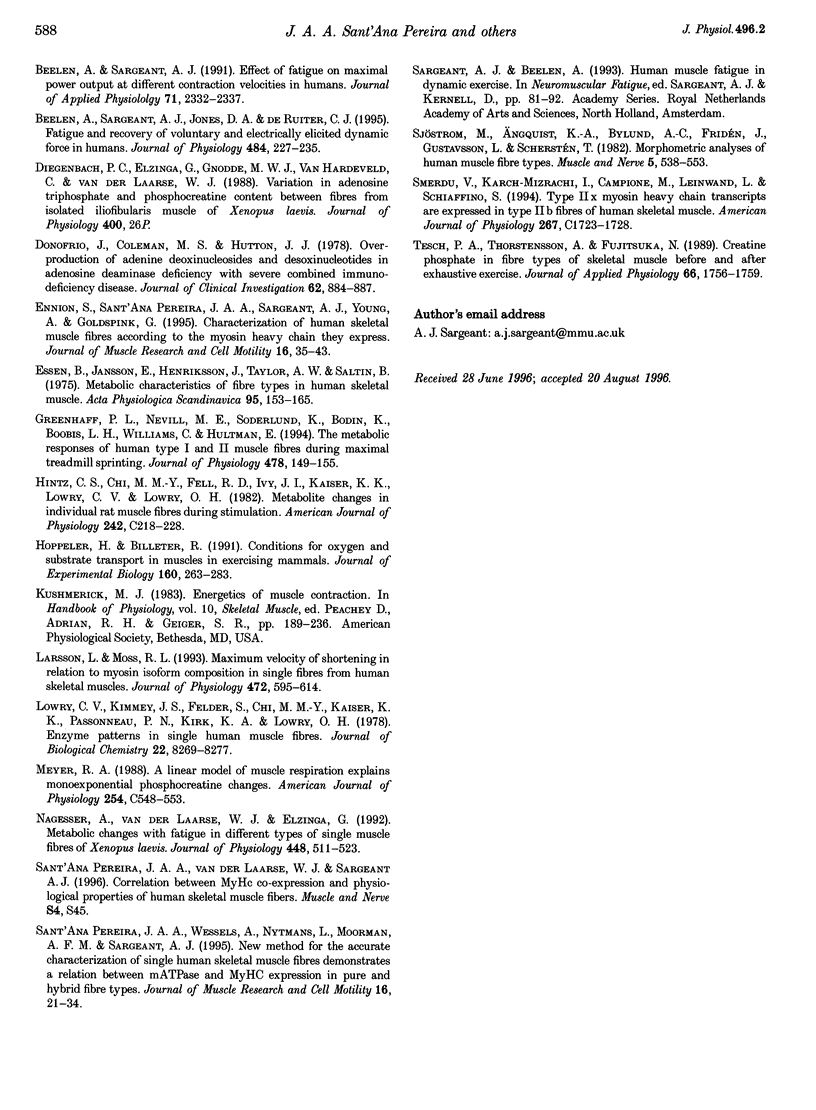
Images in this article
Selected References
These references are in PubMed. This may not be the complete list of references from this article.
- Beelen A., Sargeant A. J. Effect of fatigue on maximal power output at different contraction velocities in humans. J Appl Physiol (1985) 1991 Dec;71(6):2332–2337. doi: 10.1152/jappl.1991.71.6.2332. [DOI] [PubMed] [Google Scholar]
- Beelen A., Sargeant A. J., Jones D. A., de Ruiter C. J. Fatigue and recovery of voluntary and electrically elicited dynamic force in humans. J Physiol. 1995 Apr 1;484(Pt 1):227–235. doi: 10.1113/jphysiol.1995.sp020660. [DOI] [PMC free article] [PubMed] [Google Scholar]
- Donofrio J., Coleman M. S., Hutton J. J., Daoud A., Lampkin B., Dyminski J. Overproduction of adenine deoxynucleosides and deoxynucletides in adenosine deaminase deficiency with severe combined immunodeficiency disease. J Clin Invest. 1978 Oct;62(4):884–887. doi: 10.1172/JCI109201. [DOI] [PMC free article] [PubMed] [Google Scholar]
- Ennion S., Sant'ana Pereira J., Sargeant A. J., Young A., Goldspink G. Characterization of human skeletal muscle fibres according to the myosin heavy chains they express. J Muscle Res Cell Motil. 1995 Feb;16(1):35–43. doi: 10.1007/BF00125308. [DOI] [PubMed] [Google Scholar]
- Essén B., Jansson E., Henriksson J., Taylor A. W., Saltin B. Metabolic characteristics of fibre types in human skeletal muscle. Acta Physiol Scand. 1975 Oct;95(2):153–165. doi: 10.1111/j.1748-1716.1975.tb10038.x. [DOI] [PubMed] [Google Scholar]
- Greenhaff P. L., Nevill M. E., Soderlund K., Bodin K., Boobis L. H., Williams C., Hultman E. The metabolic responses of human type I and II muscle fibres during maximal treadmill sprinting. J Physiol. 1994 Jul 1;478(Pt 1):149–155. doi: 10.1113/jphysiol.1994.sp020238. [DOI] [PMC free article] [PubMed] [Google Scholar]
- Hintz C. S., Chi M. M., Fell R. D., Ivy J. L., Kaiser K. K., Lowry C. V., Lowry O. H. Metabolite changes in individual rat muscle fibers during stimulation. Am J Physiol. 1982 Mar;242(3):C218–C228. doi: 10.1152/ajpcell.1982.242.3.C218. [DOI] [PubMed] [Google Scholar]
- Hoppeler H., Billeter R. Conditions for oxygen and substrate transport in muscles in exercising mammals. J Exp Biol. 1991 Oct;160:263–283. doi: 10.1242/jeb.160.1.263. [DOI] [PubMed] [Google Scholar]
- Larsson L., Moss R. L. Maximum velocity of shortening in relation to myosin isoform composition in single fibres from human skeletal muscles. J Physiol. 1993 Dec;472:595–614. doi: 10.1113/jphysiol.1993.sp019964. [DOI] [PMC free article] [PubMed] [Google Scholar]
- Lowry C. V., Kimmey J. S., Felder S., Chi M. M., Kaiser K. K., Passonneau P. N., Kirk K. A., Lowry O. H. Enzyme patterns in single human muscle fibers. J Biol Chem. 1978 Nov 25;253(22):8269–8277. [PubMed] [Google Scholar]
- Meyer R. A. A linear model of muscle respiration explains monoexponential phosphocreatine changes. Am J Physiol. 1988 Apr;254(4 Pt 1):C548–C553. doi: 10.1152/ajpcell.1988.254.4.C548. [DOI] [PubMed] [Google Scholar]
- Nagesser A. S., van der Laarse W. J., Elzinga G. Metabolic changes with fatigue in different types of single muscle fibres of Xenopus laevis. J Physiol. 1992 Mar;448:511–523. doi: 10.1113/jphysiol.1992.sp019054. [DOI] [PMC free article] [PubMed] [Google Scholar]
- Sant'ana Pereira J. A., Wessels A., Nijtmans L., Moorman A. F., Sargeant A. J. New method for the accurate characterization of single human skeletal muscle fibres demonstrates a relation between mATPase and MyHC expression in pure and hybrid fibre types. J Muscle Res Cell Motil. 1995 Feb;16(1):21–34. doi: 10.1007/BF00125307. [DOI] [PubMed] [Google Scholar]
- Sjöström M., Angquist K. A., Bylund A. C., Fridén J., Gustavsson L., Scherstén T. Morphometric analyses of human muscle fiber types. Muscle Nerve. 1982 Sep;5(7):538–553. doi: 10.1002/mus.880050708. [DOI] [PubMed] [Google Scholar]
- Smerdu V., Karsch-Mizrachi I., Campione M., Leinwand L., Schiaffino S. Type IIx myosin heavy chain transcripts are expressed in type IIb fibers of human skeletal muscle. Am J Physiol. 1994 Dec;267(6 Pt 1):C1723–C1728. doi: 10.1152/ajpcell.1994.267.6.C1723. [DOI] [PubMed] [Google Scholar]
- Tesch P. A., Thorsson A., Fujitsuka N. Creatine phosphate in fiber types of skeletal muscle before and after exhaustive exercise. J Appl Physiol (1985) 1989 Apr;66(4):1756–1759. doi: 10.1152/jappl.1989.66.4.1756. [DOI] [PubMed] [Google Scholar]



